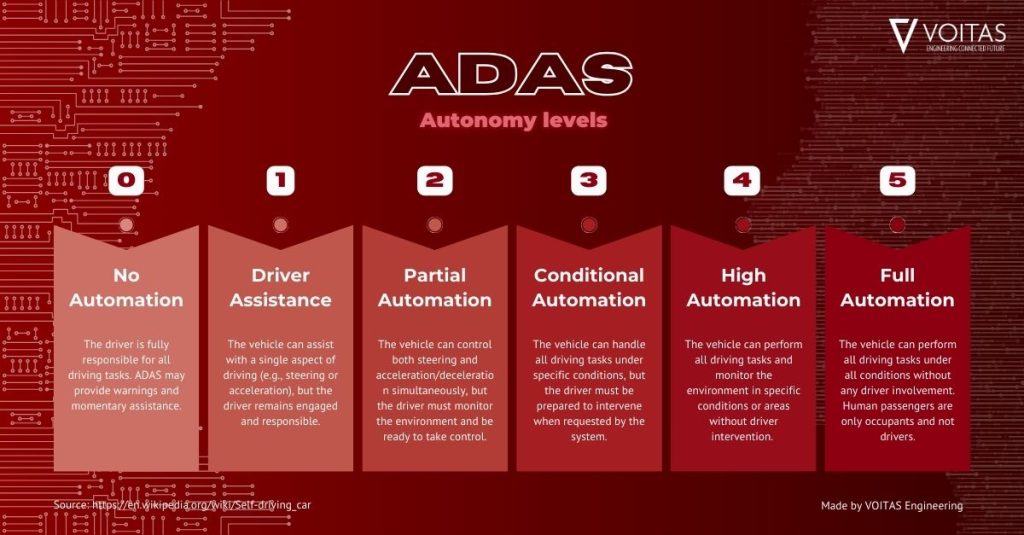Introduction to ADAS and Its Importance in Modern Vehicles
Advanced Driver Assistance Systems (ADAS) are revolutionizing the automotive industry by enhancing vehicle safety and driving efficiency. These systems leverage a range of technologies to assist drivers in navigating and controlling vehicles under various conditions. Initially introduced as luxury features, ADAS has become more widespread, reflecting significant advancements in automotive technology and a growing emphasis on road safety.
Evolution of ADAS
The evolution of Advanced Driver Assistance Systems (ADAS) reflects a remarkable journey in automotive engineering, marked by incremental innovations and significant technological breakthroughs that have transformed how vehicles interact with their environment and drivers. Over the years, these systems have evolved from rudimentary functions to complex, integrated systems capable of autonomous operation under certain conditions.
Initial Stages: Simple Assistance Functions
The roots of ADAS can be traced back to the early days of automotive safety innovations. One of the earliest forms of ADAS was the anti-lock braking system (ABS), introduced in the 1970s, which prevents the wheels from locking up during an emergency brake, allowing the driver to maintain control of the steering. Following this, other simple systems were developed, such as traction control and electronic stability control, which further enhanced vehicle safety by preventing loss of control.
During the 1990s, we saw the introduction of more direct precursors to today’s ADAS technologies. These included basic cruise control, which allows a vehicle to maintain a set speed without the driver needing to keep their foot on the accelerator. Another early form of ADAS was parking assistance technology, including rear parking sensors that alert drivers to obstacles behind the vehicle while reversing.
Advancements in Sensor Technology and Integration
The late 1990s and early 2000s marked a significant shift with the integration of multiple sensors and the application of early machine vision technologies. These developments led to the creation of features like adaptive cruise control (ACC), which not only maintains a set speed but also adjusts the speed to maintain a safe following distance from the vehicle ahead. Lane keeping assistance (LKA), which alerts drivers when they begin to drift out of their lane, and in more advanced versions, can gently steer the car back into the correct lane, became another milestone.
Emergence of Machine Learning and Connectivity
The adoption of machine learning algorithms has allowed ADAS to move from reactive to proactive operations. These systems can now learn from vast datasets collected from real-world driving conditions, improving their decision-making processes over time. For instance, predictive ADAS capabilities use historical traffic data and real-time connectivity to anticipate road conditions and adjust vehicle dynamics accordingly.
Connectivity has further expanded the capabilities of ADAS through features such as V2X (Vehicle-to-Everything) communication. This technology enables vehicles to communicate with each other and with road infrastructure, enhancing the ability of ADAS to prevent accidents by receiving and responding to signals not perceivable to human senses or standalone sensors.
Towards Autonomy: Integration of ADAS with Autonomous Driving Technologies
Today’s ADAS are foundational components in the development of autonomous driving technologies. As we progress from Level 2 and Level 3 automation, where partial automation and conditional automation require human oversight, to Level 4 and eventually Level 5, which promise high and full automation without human intervention, the role of ADAS is increasingly integral.
Systems are now capable of complex tasks such as automatic braking in emergencies, sophisticated pedestrian and obstacle detection, and even autonomous navigation in certain controlled environments. These advancements are not just milestones in automotive engineering but are setting the stage for a future where fully autonomous vehicles could become a common sight on our roads.
Core Components of ADAS
At the heart of every ADAS are its sensors, which serve as the eyes and ears of the system. These sensors include:
Key Sensors
- Cameras: Optical cameras are crucial for a wide range of functions, from recognizing traffic signs to monitoring lane markings. They provide high-resolution images that are essential for the accurate functioning of ADAS.
- Radar: Radar sensors detect the distance and speed of objects around the vehicle. They are particularly useful in adverse weather conditions where optical sensors might be impaired.
- LIDAR: Light Detection and Ranging uses laser pulses to create high-resolution 3D maps of the environment. LIDAR is instrumental in detecting the shape and distance of objects, contributing to more precise obstacle detection and avoidance.
GPS and Mapping Data
Additionally, GPS and mapping data play a crucial role in ADAS. These technologies provide positional accuracy and route information, enabling systems like adaptive cruise control and predictive driving aids to function effectively. This integration ensures that ADAS not only reacts to immediate surroundings but also anticipates road conditions ahead.
Software and Algorithms: The Brains Behind ADAS
The software that processes data from ADAS sensors is the cornerstone of these systems’ functionality. This software interprets the input from various sensors to make real-time decisions.
Role of AI and Machine Learning
Machine learning and artificial intelligence (AI) are increasingly becoming integral to ADAS development. These technologies enable systems to learn from vast amounts of data, improving their predictive capabilities over time. For example, machine learning algorithms can analyze historical data to predict potential hazards and adjust the vehicle’s response accordingly. This adaptive capability is essential for developing more advanced ADAS features, such as autonomous emergency braking and adaptive cruise control.
Levels of Autonomy in Advanced Driver Assistance Systems (ADAS)
Advanced Driver Assistance Systems (ADAS) are categorized into different levels of autonomy according to the SAE (Society of Automotive Engineers) classification system. This system ranges from Level 0, indicating no automation, to Level 5, which represents full automation. Each level reflects the degree to which a vehicle can take over driving tasks and decision-making from the human driver. Understanding these levels is crucial for assessing how ADAS technologies impact driver interaction and responsibility at each stage.

Level 0: No Automation
At Level 0, all major systems are controlled by the human driver. There is no automation, but there may be system warnings or momentary intervention for safety purposes, such as stability control and emergency braking. Human Aspect: The driver is fully engaged and responsible for monitoring the environment, making decisions, and operating the vehicle at all times.
Level 1: Driver Assistance
Level 1 vehicles have single automated systems for driver assistance, such as adaptive cruise control or lane-keeping assistance. Here, either the steering or acceleration/deceleration is automated, not both simultaneously. Human Aspect: The driver remains largely in control but is assisted by the vehicle in specific tasks, enhancing comfort or safety during long drives or in dense traffic.
Level 2: Partial Automation
At this level, the vehicle can control both steering and acceleration/deceleration under certain conditions. The driver must still monitor the vehicle and is expected to be fully engaged, ready to take over if needed. Examples include Tesla’s Autopilot and Cadillac’s Super Cruise. Human Aspect: The driver is relieved from some tasks but must remain alert and ready to intervene immediately, maintaining overall responsibility for safety.
Level 3: Conditional Automation
Vehicles at Level 3 can make informed decisions and perform safety-critical functions under certain traffic or environmental conditions, such as detecting and responding to emergency situations. The driver is still necessary but is not required to monitor the environment constantly. An example is Audi’s Traffic Jam Pilot. Human Aspect: The driver can safely turn their attention away from driving tasks in specific scenarios but must be prepared to take over when the system requests.
Level 4: High Automation
At Level 4, the vehicle can operate in self-driving mode within a predefined area or set of conditions, such as urban environments or dedicated lanes. No driver intervention is required within these limits, but beyond them, human control is needed. Examples might include robotic taxis in controlled environments. Human Aspect: Drivers are not required during automated operation, allowing them to focus on other activities. However, they must be ready to assume control when the vehicle exits the conditions of its automated domain.
Level 5: Full Automation
Finally, at Level 5, the vehicle is fully autonomous and capable of performing all driving functions under all conditions. There is no need for a driver, and such vehicles might not even have steering wheels or driver’s controls. Human Aspect: The concept of a “driver” is obsolete, as passengers are completely relieved from driving tasks, allowing total freedom during travel.
Each level of autonomy in ADAS technology showcases a shift from active driver engagement towards increased vehicle automation, reflecting profound changes in how people interact with and rely on automotive technologies for daily transportation.
Integration and Interaction with Other Vehicle Systems
ADAS does not operate in isolation but interacts seamlessly with other vehicle systems. This integration is vital for the coordinated operation of various components, such as the braking system, steering, and acceleration controls.
Integration Challenges
The challenges of integrating ADAS with traditional vehicle controls lie in ensuring reliability and safety. Engineers must design these systems to operate under a wide range of scenarios and conditions, requiring rigorous testing and validation. Furthermore, the need to maintain driver control and intervention capabilities adds another layer of complexity to the design of these systems.
Future Trends and Innovations in ADAS Technologies
The future of ADAS is marked by exciting potential developments in sensor technology and data processing. Enhanced sensor capabilities, such as improved LIDAR resolution and more sophisticated cameras, will allow ADAS to detect and interpret more complex scenarios. Additionally, the integration of 5G and Vehicle-to-Everything (V2X) communication will enhance the ability of ADAS to receive and process information from the surrounding infrastructure and other vehicles.
The Road Ahead
Predictions for the next decade include the emergence of fully autonomous vehicles, where ADAS systems evolve from assistance features to complete driving solutions. This transition will require not only technological advancements but also changes in regulatory frameworks and public acceptance.
Conclusion
In conclusion, Advanced Driver Assistance Systems are at the forefront of automotive innovation, significantly impacting vehicle safety and driving experiences. By understanding the key components and technologies of ADAS, industry professionals and enthusiasts can appreciate the engineering challenges and opportunities that lie ahead in this dynamic field. The journey from assistance to autonomy is underway, promising a future where roads are safer and driving is more efficient.





